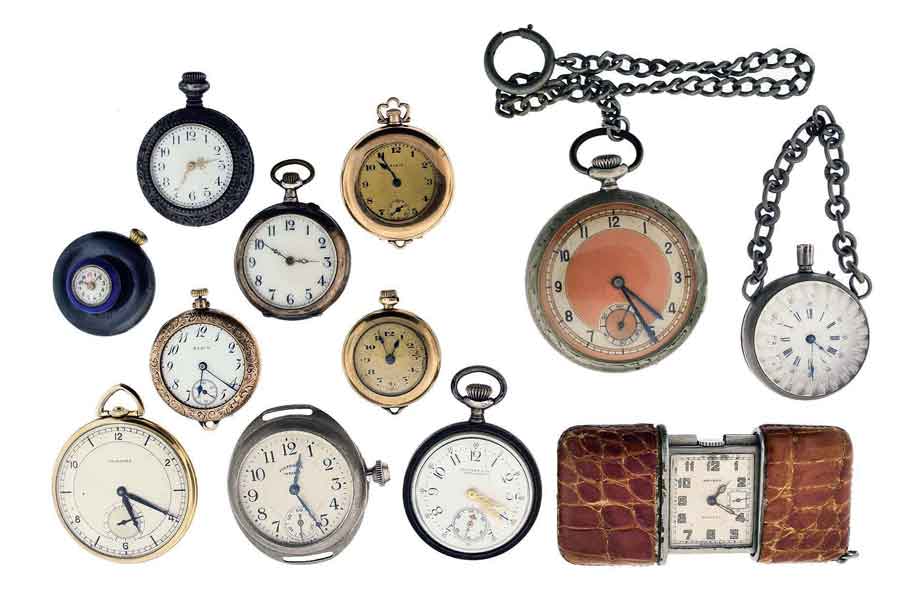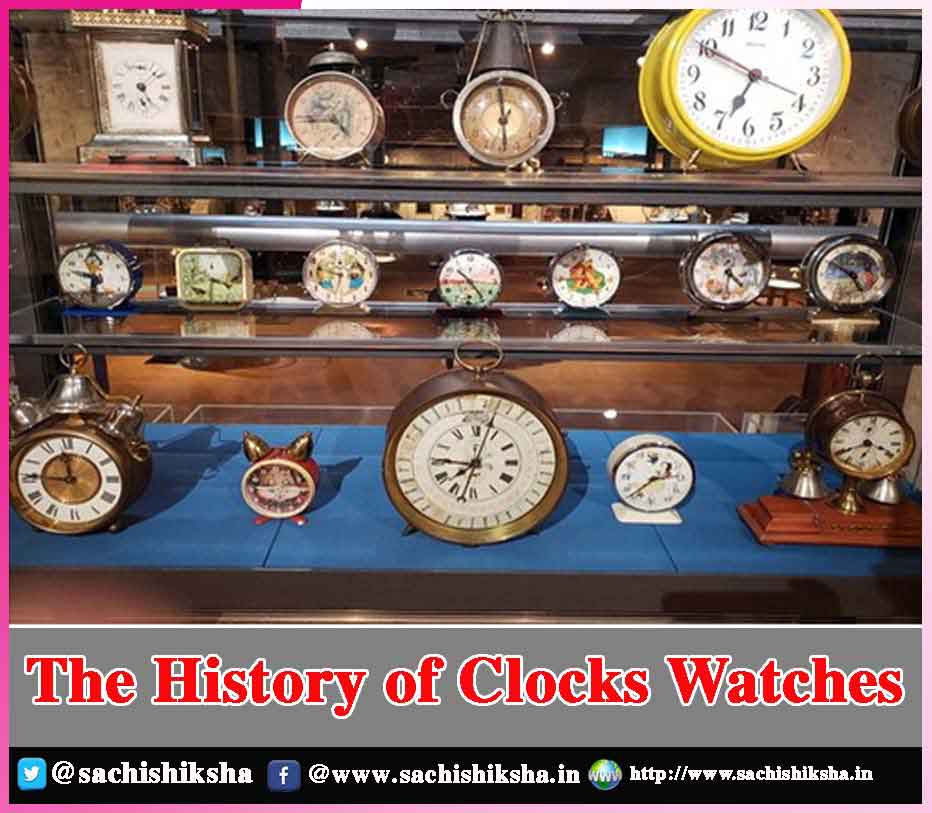The History of Clocks Watches
Introduction: The word “clock” comes from the French word cloche which means bell. It entered the language around the 14th century, around the time when clocks started hitting the mainstream. Time being a valuable part of everyone’s life doesn’t go unnoticed and unheeded by people. Maybe this is the reason, the need for timekeeping devices even arose.
Also Read:
- 5 Inventions: Remote Control, Wall Clock, Plastic, Fan & Typewriter
- THE HISTORY OF CAMERA
- History of Cyclones
- India, the Land of Faith
- HANDICRAFTS OF INDIA
Table of Contents
Timeline for the Evolution of Timekeeping Devices:

Sundials:
The oldest known sundial is from Egypt it dates back to around 1,500 B.C. Sundials have their origin in shadow clocks, which were the first devices used for measuring the parts of a day.
Greek Water Clocks:
An early prototype of the alarm clock was invented by the Greeks around 250 BC. The Greeks built a water clock which was called a ‘clepsydra’, where the rising waters would both keep time and eventually hit a mechanical bird that triggered an alarming whistle. Thus, we see how the idea for an alarm clock would have been taken from.
Hourglass:
Hourglasses were the first reusable, reasonably accurate and easily constructed time-measurement devices. I am sure most of us know about it. An hourglass comprises two glass bulbs connected vertically by a narrow neck that allows a regulated trickle of material, usually sand, from the upper bulb to the lower one. Hourglasses are still in use today. They also were adopted for use in industry, churches, cooking and households.
Monastery Clocks and Clock Towers:
Church life and specifically monks calling others to prayer made timekeeping devices a necessity in daily life. Much more sophisticated clocks and church clock towers were built by later monks. A 14th-century monk of Glastonbury, built one of the oldest clocks still in existence and continues to be in use at London’s Science Museum.
Men and women used to wear miniature clocks as pendants in the 16th century.
Slowly, the styles changed in the 17th century and men began to wear watches in pockets instead of as pendants, while the woman’s watch remained a pendant into the 20th century. This is said to have occurred in 1675.To fit in pockets, their shape evolved into the typical pocket watch shape, rounded and flattened with no sharp edges. Glass was used to cover the face.
Wrist Watch:
In 1504, the first portable timepiece was invented in Nuremberg, Germany by Peter Henlein. It was not very accurate. The first reported person to actually wear a watch on the wrist was the French mathematician and philosopher, Blaise Pascal. He wore it with a piece of string, he attached his pocket watch to his wrist.
Minute Hand:
In 1577, Jost Burgi invented the minute hand. This, I believe, was a breakthrough in the history of clocks since modern day wall clocks have hands.
Pendulum Clock:
In 1656, the pendulum clock was invented, making clocks more accurate.The first accurate timekeepers depended on the phenomenon known as harmonic motion, in which the restoring force acting on an object moved away from its equilibrium position just like how we see pendulums moving with the help of an extended spring which acts to return the object to that position, and causes it to oscillate.
Harmonic oscillators can be used as accurate timekeepers as the period of oscillation does not depend on the amplitude of the motion—and so it always takes the same time to complete one oscillation. The period of a harmonic oscillator is completely dependent on the physical characteristics of the oscillating system and not the starting conditions or the amplitude.
Mechanical Alarm Clock:
The first mechanical alarm clock was invented. However, the ringing bell alarm on his clock could ring only at 4 a.m. In 1876, a mechanical wind-up alarm clock that could be set for any time was patented. It was a great development in the history of watches.
Standard Time:
Sir Sanford Fleming invented standard time in 1878. Standard time is the synchronisation of clocks within a geographical area to a single time standard. It developed out of a need to aid weather forecasting and train travel. In the 20th century, the geographical areas were evenly spaced into time zones. Once again it was a great development and helped to create time zones.
Thomas Tompion was one of the first clock makers to recognise the potential of the balance spring and used it successfully in his pocket watches; the improved accuracy enabled watches to perform as well as they are generally used today, as a second hand to be added to the face, a development that occurred during the 1690s. The concentric minute hand was an earlier invention, but a mechanism was devised by Quare that enabled the hands to be actuated together.
Military Use of the Watch:
Watches were worn during the Franco-Prussian War (1870–1871), and by the time of the Boer War (1899–1902), watches had been recognised as a valuable tool. Early models were essentially standard pocket watches fitted to a leather strap, but by the early 20th century, manufacturers began producing purpose-built wristwatches.
Quartz Clock:
In 1927, Canadian-born Warren Marrison, a telecommunications engineer, developed the first quartz clock, a highly accurate clock based on the regular vibrations of a quartz crystal in an electrical circuit. It was invented while searching for reliable frequencies.
Battery-Powered Clock:
The Warren Clock Company was formed in 1912 and produced a new type of clock run by batteries, prior to that, clocks were either wound or run by weight.
In 2013 Cesium 133 Atomic Watch was introduced. It was the first watch to keep time with an internal atomic clock. This watch contains a tiny cesium atomic clock on a chip. It is reported to keep time to an accuracy of one second in 1000 years.
The watch is based on a chip developed by the breakthrough Chip Scale Atomic Clock (CSAC) program of the US Defence Advanced Research Projects Agency (DARPA) which was initiated in 2001, and produced the first prototype atomic clock chip in 2005.
Smart Watch:
While conventional watches and clocks are still widely in use we also observe new developments and technologies in these timepieces. We all are aware of the smartwatches that are a new favourite.
A smartwatch is a computer worn on the wrist, a wireless digital device that may have the capabilities of a cell phone, portable music player, or a personal digital assistant. It can perform many functions. Be it measuring the number of steps (helps burn calories and regulate our health), receive phone calls, operate different applications and so much more.
They have the general capabilities of a smartphone, having a processor with a mobile operating system capable of running a variety of mobile apps. So, we see that this history is very interesting and it clearly shows that slow advancements and gradual technological developments led to the modern day clocks that are so crucial to man’s life today.















































